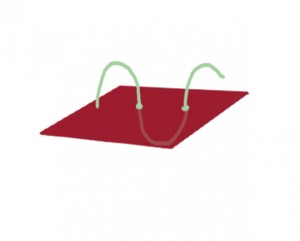| When estimating number, the ‘countable event’ is a unique point on the particle. In order to identify this unique point or leading edge, number estimation must be carried out in a volume; either with physical sections along the z axis or with optical sections. The unique point is called Q-. |
|
| To estimate length a surface probe is used and the event counted is the intersection of the string with the surface. This event is referred to as Q in the literature. |  |
| To estimate surface you could use another surface as the probe, but when the two surfaces intersect it will create a line-segment that is called a boundary (B). While the relationship between the amount of surface used to probe with and the length of B is known (surface per volume is estimated by [4 /pi] times the boundary per area: for a derivation see Smith, C.S. and L. Guttman, 1953, Measurement of Internal Boundaries in Three-Dimensional Structures By Random Sectioning, Transactions AIME (Journal of Metals), Vol. 197, issue 1, pp. 81 -87. equation 7), tracing B is not the same as counting an event. More bias will be introduced by tracing B than by marking an event, and it will take longer. Therefore line-segments are used to probe for surface. When the line-segment-probe and the surface interact, the event is a crossing point, or intersection (I). |  |
| To estimate volume, a surface or a line-segment could be used as the probe. But the interaction of a surface with a volume is a cross-sectional area, and the interaction of a line-segment with a volume is a line-segment, neither of which are as easy or as fast to indicate as an event. The volume of interest per volume probed is estimated by either the ratio of area of interaction to area probed with or line-segment length of interaction to line-segment length probed with; but neither shading an area nor tracing a line segment is as easy or quick as marking an event. In this case an event will result if points (P) are used as the probe. |  |
____________________________________________________________________

Sponsored by MBF Bioscience
developers of Stereo Investigator, the world’s most cited stereology system
